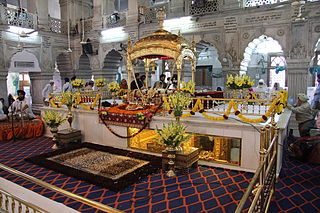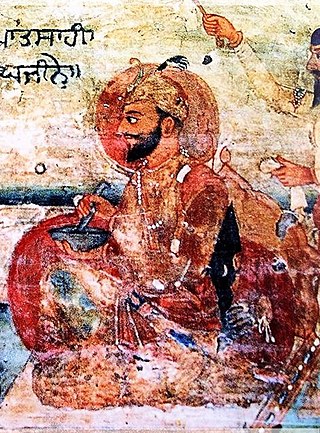A gurdwara or gurudwara is a place of assembly and worship for Sikhs. Sikhs also refer to gurdwaras as Gurdwara Sahib. People from all faiths are welcomed in gurdwaras. Each gurdwara has a Darbar Sahib where the Guru Granth Sahib is placed on a takhat in a prominent central position. Any congregant may recite, sing, and explain the verses from the Guru Granth Sahib, in the presence of the rest of the congregation.
Waheguru is a term used in Sikhism to refer to God as described in Guru Granth Sahib. It is the most common term to refer to God in modern Sikhism.
The following outline is provides an overview of Sikhism, or Sikhi.

The Ardās is a set prayer in Sikhism. It is a part of worship service in a Gurdwara, daily rituals such as the opening the Guru Granth Sahib for prakash or closing it for sukhasan in larger Gurdwaras, closing of congregational worship in smaller Gurdwaras, rites-of-passages such as with the naming of child or the cremation of a loved one, daily prayer by devout Sikhs and any significant Sikh ceremonies.

The laava phere, also known as Lavan, are the four hymns of the Anand Karaj which form the main part of this ceremony. The four hymns are from the Guru Granth Sahib, the Sikh holy scriptures and appear on Ang 773 to 774 of the total of 1430. The Laavaan Shabad was written by the Fourth Guru, Guru Ram Daas Ji.

The Khanda is the symbol of the Sikh faith (Sikhism) which attained its current form around the 1930s during the Ghadar Movement.

The Nishan Sahib in Sikhism is a triangular flag made of cotton or silk cloth, with a tassel at its end. The current form of the Nishan Sahib that is in use throughout Gurdwaras around the world has an Blue color that has the symbol in the center of the flag. It is commonly hoisted on a tall flagpole outside Gurdwaras.

Darbar Sahib, or Darbar Hall, literally means the Imperial Court, and often refers to the main room within a Gurdwara. This room is where the Guru Granth Sahib sits on a raised throne, or takht in a prominent central position.

The Akhand Kirtani Jatha, alternatively romanized as the Akhand Keertanee Jathaa and abbreviated as AKJ, is a jatha and sect of Sikhism dedicated to the Sikh lifestyle. The Jatha follows a strict discipline in keeping the Rehat of Guru Gobind Singh. They also enjoy an active style of Keertan recited by Sikhs in a collective manner in front of Guru Granth Sahib. This style of Keertan is relatively simple, and the entire congregation devotionally participates in singing along.

Nitnem is a collection of Sikh hymns (Gurbani) to be read minimally 3 different times of the day. These are mandatory and to be read by every Amritdhari Sikh as expressed in the Sikh Rehat Maryada. Optionally additional prayers may be added to a Sikh's nitnem. There are five hymns (Five Banis) to be done during Amrit Vela, the Rehras Sahib hymn for the evening and Kirtan Sohila for the night. The morning and evening prayers should be followed by an Ardaas.
Akhand Path The continuous and uninterrupted recitation of Sri Guru Guru Granth Sahib Ji is known as Akhand Path Sahib.
Rehat refers to the rules and traditions which govern the unique Sikh lifestyle and determines correct Sikh orthodoxy and orthopraxy. The Sikh Rehit Maryada is a code of conduct and conventions for Sikhism. The final version of the Rehat Maryada was approved by the Shiromani Gurdwara Parbandhak Committee, Amritsar in 1945. The Rehat Maryada was created to provide guidance to Sikhs on practical and functional aspects of daily life, including the operations of Sikh Gurdwaras, and religious practices to foster cohesion throughout the community. Rehitnāma is a Punjabi term that refers to a genre of Sikh religious literature which expounds upon specifiying an approved way of life for a Sikh.
Gurpurab, alternatively spelt as Gurpurb or Gurpurub, in Sikh tradition is a celebration of an anniversary of a Guru's birth marked by the holding of a festival.
A Hukamnama, in modern-times, refers to a hymn from the Guru Granth Sahib which is given as an injunction, order, or edict to Sikhs. It also refers to edicts issued by the contemporary Takhts. In the historical sense, it was used to refer to an issued injunction, order, or edict given by one of the Gurus of Sikhism or their officiated followers and associates during their lives.
The following list consists of concepts that are derived from both Sikh and Indian tradition. The main purpose of this list is to disambiguate multiple spellings, to make note of spellings no longer in use for these concepts, to define the concept in one or two lines, to make it easy for one to find and pin down specific concepts, and to provide a guide to unique concepts of Sikhism all in one place.
Antam Sanskar refers to the funeral rites in Sikhism. Antam means "final", while sanskar means "rite".

A Balmiki temple is called an Ashram, which means a hermitage or monastery. It is the communal house for Balmikis. The function of the Ashram is to serve as a center for building up devotees' commitment and for transmitting the Ramayana's message, and the focal point for the whole community to preserve their culture and traditions.

The 52 Hukams are a set of instruction in Sikhism set by Guru Gobind Singh in Nanded, Maharashtra, India in 1708. These edicts sum up the ideal way of life of the Khalsa and serve as a code of conduct for the Khalsa Panth. Members of the Khalsa aim to follow all the 52 edicts.

Amrit Sanskar also called Amrit Parchar, Amrit Sanchar, Khande di Pahul, or Khande Batte di Pahul is one of the four Sikh Sanskaars. The Amrit Sanskar is the initiation rite introduced by Guru Gobind Singh when he founded the Khalsa in 1699.

The Gurdwara Sahib Woolwich is a Sikh gurdwara in central Woolwich in the Royal Borough of Greenwich, South East London. It was built in 1814–16 as a Methodist church and converted into a Sikh place of worship in the late 1970s. The main hall is Grade II-listed; the former Soldier's Institute and Sunday School next door, now in use as a langar hall, is not.










